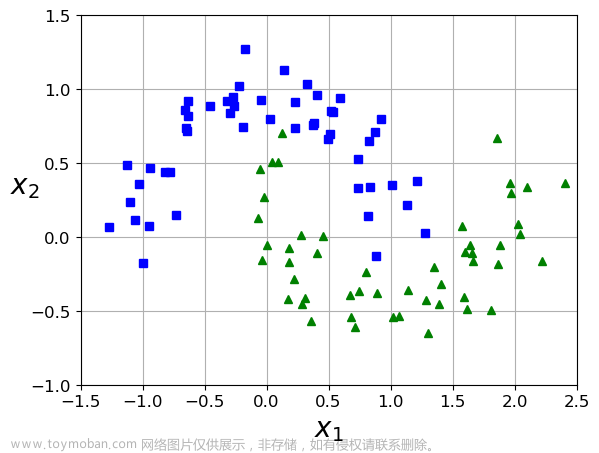目录
文章目标:
1,导入库
2,导入数据集
3,缩放/归一化训练数据
4,创建并拟合回归模型
5,查看参数
6,预测
7,可视化
有一个开源的、商业上可用的机器学习工具包,叫做[scikit-learn](https://scikit-learn.org/stable/index.html)。这个工具包包含了你在本课程中要使用的许多算法的实现。
文章目标:
利用scikit-learn使用梯度下降法实现线性回归
使用线性回归模型SGDRegressor进行预测_无桨靠浪的博客-CSDN博客
1,导入库
import numpy as np
#设计array对象中数据的精度
np.set_printoptions(precision=2)
#导入线性模型,LinearRegression,还有梯度下降函数SGDRegressor
from sklearn.linear_model import LinearRegression, SGDRegressor
#导入数据预处理库,使用正则化函数
from sklearn.preprocessing import StandardScaler
#导入数据集
from lab_utils_multi import load_house_data
import matplotlib.pyplot as plt
dlblue = '#0096ff'; dlorange = '#FF9300'; dldarkred='#C00000'; dlmagenta='#FF40FF'; dlpurple='#7030A0';
plt.style.use('./deeplearning.mplstyle')Scikit-learn有一个梯度下降回归模型[sklearn.linear_model.SGDRegressor](https://scikit-learn.org/stable/modules/generated/sklearn.linear_model.SGDRegressor.html#examples-using-sklearn-linear-model-sgdregressor)。 像你之前实现的梯度下降一样,这个模型在归一化的输入下表现最好。[sklearn.preprocessing.StandardScaler](https://scikit-learn.org/stable/modules/generated/sklearn.preprocessing.StandardScaler.html#sklearn.preprocessing.StandardScaler)将执行z-score归一化。在这里,它被称为 "标准分数"。
2,导入数据集
X_train, y_train = load_house_data()
X_features = ['size(sqft)','bedrooms','floors','age']
3,缩放/归一化训练数据
scaler = StandardScaler()
X_norm = scaler.fit_transform(X_train)
print(f"Peak to Peak range by column in Raw X:{np.ptp(X_train,axis=0)}")
print(f"Peak to Peak range by column in Normalized X:{np.ptp(X_norm,axis=0)}")print(np.ptp(x, axis=0)) # 求极值(最大最小值的差)
print(f‘‘)的用法_Joey9898的博客-CSDN博客
4,创建并拟合回归模型
sgdr = SGDRegressor(max_iter=1000)
sgdr.fit(X_norm, y_train)
print(sgdr)
print(f"number of iterations completed: {sgdr.n_iter_}, number of weight updates: {sgdr.t_}")5,查看参数
注意,这些参数是与*规范化*的输入数据相关的。拟合的参数非常接近于在以前的材料中用这个数据发现的参数。
b_norm = sgdr.intercept_
w_norm = sgdr.coef_
print(f"model parameters: w: {w_norm}, b:{b_norm}")
print(f"model parameters from previous lab: w: [110.56 -21.27 -32.71 -37.97], b: 363.16")6,预测
# make a prediction using sgdr.predict()
y_pred_sgd = sgdr.predict(X_norm)
# make a prediction using w,b.
y_pred = np.dot(X_norm, w_norm) + b_norm
print(f"prediction using np.dot() and sgdr.predict match: {(y_pred == y_pred_sgd).all()}")
print(f"Prediction on training set:\n{y_pred[:4]}" )
print(f"Target values \n{y_train[:4]}")7,可视化
# plot predictions and targets vs original features
fig,ax=plt.subplots(1,4,figsize=(12,3),sharey=True)
for i in range(len(ax)):
ax[i].scatter(X_train[:,i],y_train, label = 'target')
ax[i].set_xlabel(X_features[i])
ax[i].scatter(X_train[:,i],y_pred,color=dlorange, label = 'predict')
ax[0].set_ylabel("Price"); ax[0].legend();
fig.suptitle("target versus prediction using z-score normalized model")
plt.show()
文章来源:https://www.toymoban.com/news/detail-446258.html
Python scikit-learn,回归(预测),线性回归,正规方程方式求解系数 LinearRegression,梯度下降方式求解系数 SGDRegressor。模型的保存与加载 joblib_houyanhua1的博客-CSDN博客文章来源地址https://www.toymoban.com/news/detail-446258.html
到了这里,关于机器学习算法实战(scikit-learn版本)---线性回归的文章就介绍完了。如果您还想了解更多内容,请在右上角搜索TOY模板网以前的文章或继续浏览下面的相关文章,希望大家以后多多支持TOY模板网!











